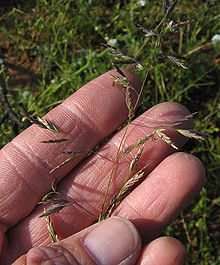Poa secunda
| Poa secunda | |
|---|---|
 |
|
| Scientific classification | |
| Kingdom: | Plantae |
| (unranked): | Angiosperms |
| (unranked): | Monocots |
| (unranked): | Commelinids |
| Order: | Poales |
| Family: | Poaceae |
| Genus: | Poa |
| Species: | P. secunda |
| Binomial name | |
|
Poa secunda J.Presl |
|
| Synonyms | |
|
N O T E : This list has been aggregated from three sources, each having considerably differing lists of taxa
|
|
N O T E : This list has been aggregated from three sources, each having considerably differing lists of taxa
Poa secunda (variously known by the common names of Sandberg bluegrass,alkali bluegrass,big bluegrass,Canby's bluegrass,Nevada bluegrass,one-sided bluegrass,Pacific bluegrass,pine blugrass,slender bluegrass,wild bluegrass, and curly bluegrass.) is a widespread species of grass native to North and South America. It is highly resistant to drought conditions, and provides excellent fodder; and has also been used in controlling soil erosion, and as revegetator, often after forest fires.Cultivars include 'Canbar', 'Service', 'Sherman', and 'Supernova'. Historically, indigenous Americans, such as the Gosiute of Utah, have used P. secunda for food. It was originally described botanically in 1830 by Jan Svatopluk Presl, from a holotype collected from Chile by Thaddäus Haenke in 1790.
...
Wikipedia

